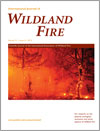International Journal of Wildland Fire
Volume 21
Number 6 2012
Prescribed burning may mitigate carbon emissions from unplanned fires. This requires an ‘outlay’ of carbon emissions to achieve a future ‘saving’ from reduced wildfire activity. Modelling for Australian eucalypt forests suggests that an overall net saving of carbon emissions may be difficult to achieve, in contrast to Australian tropical savannas.
Total charcoal and charcoal morphotypes were used to assess changes to fire regimes in NW Ontario – increases during the mid-Holocene warm period suggest increased fire activity. Charcoal morphotypes are consistent with independent climate reconstructions, unlike total charcoal. Findings suggest a two- to three-fold increase in reconstructed fire frequency.
We built linear regression models using monthly meteorological variables and the recorded fire activity in 15 ecozones of peninsular Spain. Valid models were applied to the climatic scenarios SRES A2 and B2 pointing to a very relevant increase in fire activity.
Using a temporal series of Landsat imagery, we demonstrated that fire recurrence did not influence other components of fire regime such as patch extent or shape, or ecosystem resilience. The relevance of the different environmental drivers behind vegetation recovery processes was not related to fire recurrence and changed over time. The conclusions have implications in habitat management applications.
We used remote sensing for mapping fire dynamics in the tropical savannas of Australia and to study the effects of fire on bird diversity. Our results suggest that large late dry-season fires have a negative effect on bird diversity and that MODIS imagery at a spatial resolution of 250 m is cost-effective for monitoring vegetation and fires in these areas.
Grassland curing, fuel load, Grassland Fire Danger Index (GFDI) and potential fire-line intensity were modelled for alternative climates and locations in south-eastern Australia. Climate effects on modelled future fire-line intensity were mixed because higher fire danger was often largely compensated for by lower fuel loads. Modelled changes in future GFDI and potential fire-line intensity derived from GRAZPLAN variables were small compared with effects arising from using constant maximum curing (100%) and average fuel loads (4.5 t ha–1).
The manner in which the resinous bond that holds the tips of the scales of serotinous cones of jack pine and lodgepole pine together is broken, is dictated by the type of fire. In surface fires, it occurs as a result of convective and radiative heating of the live overstorey canopy, and in crown fires by direct flame contact; seed mortality is associated with active crowning where flame-front residence times at the ground surface exceed 50 s.
We have measured the radiant energy release from combustion of mixed-oak forest litter. We found that the total radiant energy was related linearly to fuel consumption and that radiant energy fraction was 0.17 (average) while the convection and soil heating fraction was inferred to be 0.71 for these experiments.
Simulation of wildfire activity in a south-western ponderosa pine forest under a warmer and drier climate resulted in minimal increases in fire behaviour without a corresponding increase in wind speed. Ecological restoration treatments dramatically reduced fire behaviour, even under warmer and drier conditions, but effectiveness was limited by the size of diameter cap imposed on the treatment.
We report statistical models of counts of intentionally ignited wildfires in Galicia, Spain, that are derived from crime theory and that utilise information on recent and nearby wildfires for prediction. Employed as forecasting tools, these models out-perform several competing alternative tools. As instruments of policy analysis, models quantify the efficacy of law-enforcement efforts.
This study compared fuel hazard ratings generated by five assessment teams using two Australian hazard assessment methods in two dry sclerophyll forest sites on Sydney’s urban fringe. We found significant differences between teams on most variables, including hazard scores. Inconsistency in scoring fuel hazard may lead to discrepancies in a range of management applications.
A case study of a rural New Zealand community that experienced wildfire points to the need to focus on process elements when building adaptive capacity for natural disasters.
The purpose of this study was to generate a mid-season (July) fitness profile for a crew of wildland hotshot firefighters. All fitness scores for body composition, aerobic and musculoskeletal fitness and flexibility were at or above average compared with sex- and age-corrected norms and US Forest Service interagency hotshot crew (IHC)-specific recommendations.




